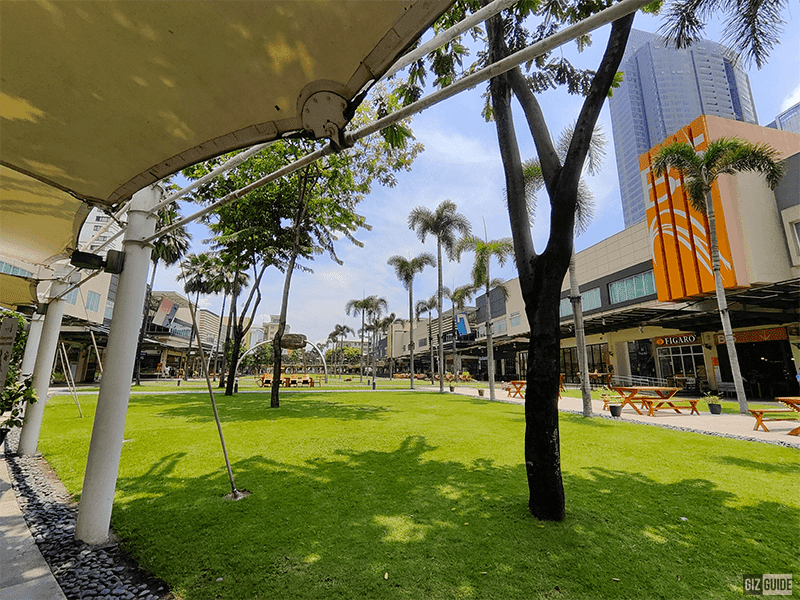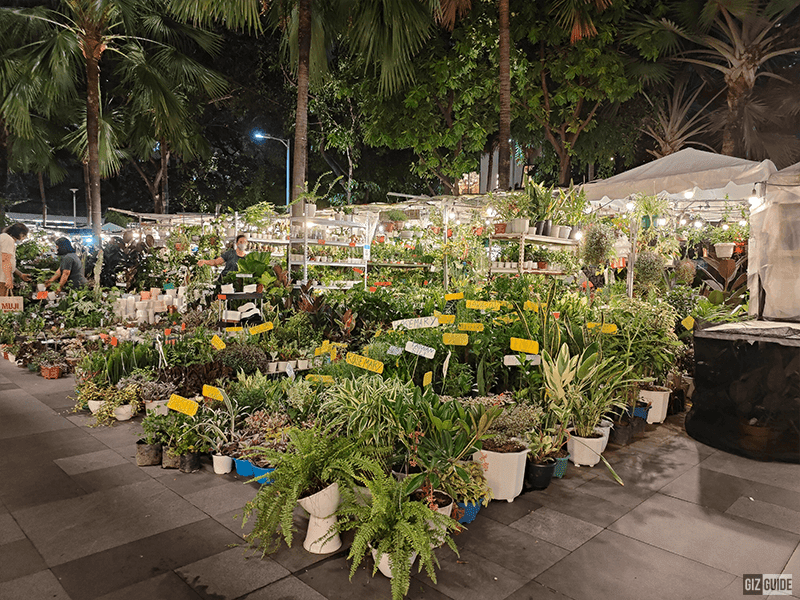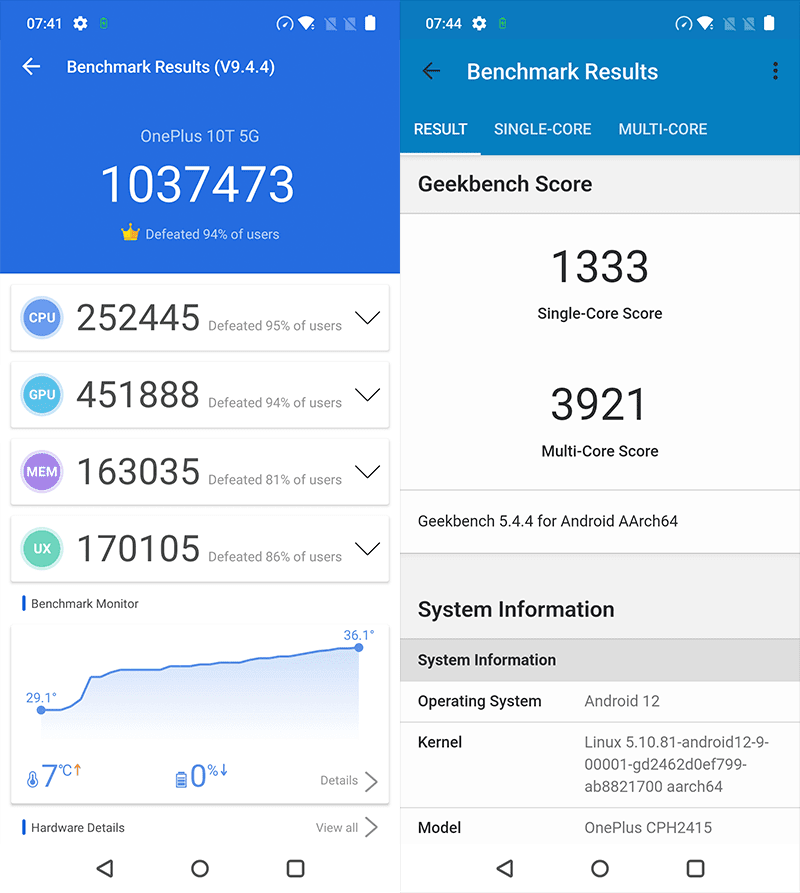.gif)
We share our thoughts and experiences with the recently launched OnePlus 10T after two weeks as our daily driver.
 |
| Is this the return of the flagship killer? |
To recap, the OnePlus 10T is the company's latest smartphone with the new 4nm Qualcomm Snapdragon 8+ Gen 1 octa-core processor, Adreno GPU, LPDDR5 RAM, UFS 3.1 storage, and 4,800mAh battery with 150W SuperVOOC fast charging.
At the back of the phone are the 50MP primary camera, 8MP ultra-wide, and the 2MP macro with an LED flash while in front is the 16MP selfie camera.
In the Philippines, the OnePlus 10T starts at PHP 35,990 for the 8GB/128GB model.
Let's dive into the full review.
Multimedia Experience
 |
| Beautiful panel? |
For the display, the handset has a large 6.7-inch Gorilla Glass protected 10-bit Fluid AMOLED screen with a 120Hz refresh rate, 360Hz refresh rate, and a 2412 x 1080 resolution.
There are panels with higher pixel densities than the panel on the OnePlus 10T but the image and text produced are still sharp and crisp. The panel is bright with vibrant color and with deep contrast.
It is a 10-point multi-touch panel that is quick, responsive, and accurate in detecting our taps and our gestures.
Around the panel are super slim bezels. On the upper part of the panel is the punch hole that houses the front-facing camera. Above the panel is the earpiece.
On top of the panel is the pre-installed screen protector.
 |
| Top and bottom |
For audio, the OnePlus 10T features stereo speakers that are made up of the bottom-firing speaker and the earpiece. The sound produced is clear with a decent sound stage and decent maximum volume. It offers both the left and right channels for a more immersive audio experience but because the one is an earpiece, the sound from the earpiece isn't as strong as the bottom-firing speaker.
We would also recommend being careful not to cover the speaker grill as the sound becomes muffled right away.
There is no 3.5mm audio jack and no USB-C to 3.5mm audio jack dongle included.
The microphones pick up sounds from a meter away. It does a decent pick-up of sound while the noise-cancellation for calls is good.
Cameras
 |
| Rear cameras |
As mentioned earlier, the rear cameras are made up of a 50MP f/1.8 Sony IMX766 primary camera, 8MP f/2.2 119-degree ultra-wide-angle camera, and 2MP 2-4cm macro camera with an LED flash.
The macro camera is nearly useless and we would have liked it better if OnePlus just used two cameras. They could have made the specs of its secondary ultra-wide camera better.
Anyway, the stock camera app has the following modes: Photo, Video, Pro, Portrait, Night, Pano, Macro, Movie, Slo-Mo, Time-Lapse, Long Exposure, Dual-View Video, and Tilt-Shift.
The PRO mode allows for controls of white balance, exposure compensation (+-2), ISO (100-6400), and shutter speed (32 seconds to 1/8000s).
Rear Camera Samples
 |
| Daylight 1x |
 |
| Daylight 2x |
 |
| Daylight ultra-wide |
The camera app lets the user shoot with the main camera and the ultra-wide. The 2x is a crop of the main camera.
The images produced are sharp and detailed enough. These images are not the best in class but it is better than the current image quality from the mid-range offerings.
 |
| Close-up |
The same can be said for close-ups. It is worth noting that the depth of field is shallow even when close-up so getting most of the subject in focus is difficult. However, the transition between the in-focus and out of focus areas is smooth.
 |
| Rear portrait mode |
The rear camera's portrait mode is impressive. It managed to detect the statue's edges and then separate it from the background. The faux bokeh is not the smoothest but it works.
 |
| Indoors 1x |
 |
| Indoors 2x |
 |
| Indoors ultra-wide |
Indoors, the images retain the quality of daylight images. The colors and contrast are great while being sharp and detailed. Again, these images are not as impressive as the latest flagships.
 |
| Lowlight 1x |
 |
| Lowlight 2x |
 |
| Lowlight ultra-wide |
The main camera, 2x telephoto, and ultra-wide cameras are able to produce impressive low-light images. The image is decently sharp and detailed with acceptable contrast and vibrant color. What makes it impressive is the minimized levels of noise.
The main camera obviously captures the most details and colors among its cameras.
Our only concern is that bright areas or light sources tend to overexpose. Moreover, these light sources turn into a weird triangle shape when taken with the ultra-wide camera.
 |
| Night mode 1x |
 |
| Night Mode 2x |
 |
| Night Mode ultra-wide |
With the Night mode, the low light images are significantly improved. There is barely any noise while the color and sharpness have been enhanced.
However, like the ultra-wide low light images, it has weird triangle-shaped light sources. It has a darker and slightly reddish/brownish hue as well.
On the punch hole is a 32MP f/2.45 selfie camera.
The stock camera mode comes with Photo, Video, Portrait, and Night.
Selfie Camera Samples
 |
| Daylight selfie |
The selfie camera takes good selfies. The image is decently sharp with vibrant color and good contrast.
 |
| Portrait mode |
The selfie Portrait mode is good. The artificial bokeh is pleasing and near natural. Our minor concern is that the edge detection managed to detect a majority of the subject but struggled with individual hair fibers.
Otherwise, it is on par with the current flagship selfie camera edge detection.
 |
| Indoor selfie |
Indoors, the image quality is the same as in daylight. It is vibrant and contrasty with good color.
 |
| Low light selfie |
In low light, the camera takes selfies with minimal noise but it is prone to overexposing bright areas in the frame.
 |
Night mode selfie
|
The Night mode remedies this by significantly improving the detail in the bright areas while reducing the grain and improving the color, contrast, and sharpness.
The rear camera can capture up to 4K at 60fps while the front-facing camera can capture up to 1080p but with no option to select the frame rate. The rear camera has a super steady mode that is locked at 1080p 60fps. It would have been better if the selfie cam has a 4K option, especially in this content creation/reels era.
The footage from both the front-facing camera and the rear-facing camera captures sharp, detailed, and vibrantly colored footage.
Performance
 |
| AnTuTu and GeekBench |
To recap, OnePlus 10T carries the following specs: 4nm Qualcomm Snapdragon 8+ Gen 1 5G octa-core processor, Adreno next-gen GPU, 8GB/16GB LPDDR5 RAM, and 128GB/256GB UFS 3.1.
 |
| 3DMark and CPDT |
OnePlus 10T benchmarks:
- AnTuTu - 1,037,473
- Geekbench 5 - 1,333 (single-core), 3,921 (multi-core)
- 3D Mark WildLife Extreme - 2,774 at 16.6 average fps
- CPDT - 942.18 MB/s sequential read speeds and 482.34 sequential write speeds
The scores are consistent with smartphones equipped with the same Snapdragon 8+ Gen1. What's noteworthy is the multi-core performance in GeekBench and the sequential read speeds of the internal storage.
During the benchmark run, the phone did warm up but by an average of 5 degrees only. What surprised us is during the AnTuTu run, the phone did not lose any battery percentage.
 |
| Genshin Impact Graphics |
 |
| Genshin Impact Performance |
In Genshin Impact, the smartphone managed to unlock the medium graphics settings which are common for flagship smartphones and gaming phones.
During the game, we would get an average of 23 fps when there are a ton of animations on screen. As you can see that 28 percent of the GPU is used and 51 percent of the CPU. These are all in line with the same SoC.
For security, the OnePlus 10T has an optical type of under-display-mounted fingerprint sensor (In-Display) and face unlock. Initial set-up and subsequent uses are almost instantaneous. Either Face Unlock or the fingerprint sensors almost never failed. The sensor only struggled when our fingers were filled with dirt.
In terms of connectivity, we have the following: WiFi 6, 5G, 4G LTE, Bluetooth 5.2, OTG, GPS, A-GPS, GLONASS, and dual SIM.
 |
| Battery benchmark and usage |
Inside the phone is a large 4,800mAh battery. It managed to last for 14 hours and 39 minutes with our usual PCMark battery benchmark.
In our daily use, it managed to last for nearly 5 hours of on-screen time where we played over 1 hour and 38 minutes of Genshin Impact.
150W fast charging is ridiculously fast!
The massive battery charges via USB-C with the 150W charger. It takes under 30 minutes to charge from 0 to 100 percent.
In short, the battery life is only okay but it can easily be remedied by the insanely fast charging time.
 |
| "OxygenOS" |
It is running on OxygenOS 13 which is based on Android 12. Some will argue that the skin is more similar to OPPO's ColorOS than the legacy OxygenOS. In our experience, the visual design of OxygenOS is present while the performance is snappy. This is purely subjective, but the older OxygenOS felt more near stock while this version feels more feature-packed. Whether or not this is a benefit is up to the user.
Otherwise, we enjoyed this new OxygenOS because of its efficient and customizable nature.
Pros - Glass front and glass back panels, lightweight and solid body, vibrant and crisp display, great main rear camera, super-fast performance for the price, 150W fast charging is ridiculously fast
Cons - Ultra-wide camera produces weird triangle bokeh in low light, 1080p maximum selfie video resolution, near useless macro camera
OnePlus 10T Specs
Display: 6.7-inch Gorilla Glass protected 10-bit Fluid AMOLED screen w/ 120Hz refresh rate, 360Hz touch sampling rate, HDR10+, FHD+ 2412 x 1080 resolution at 394 ppi
CPU: 3.2GHz 4nm Snapdragon 8+ Gen 1 octa-core processor
GPU: Adreno
RAM: 8GB/16GB LPDDR5
ROM: 128GB/256GB UFS 3.1
Back Camera: 50MP f/1.8 Sony IMX766 w/ All pixel omni-directional AF (PDAF, LAF, CAF), OIS + 8MP f/2.2 119-degree ultra-wide-angle + 2MP 2-4cm macro + LED flash
Selfie Camera: 16MP f/2.4 w/ EIS
Battery: 4,800mAh w/ 150W SUPERVOOC
OS: Android 12 w/ OxygenOS 13
Connectivity: WiFi 6 2x2 MIMO, 5G, 4G LTE, Bluetooth 5.2 (SBC, AAC, aptX HD, LDAC), GPS (L1 + L5), GLONASS, Galileo, BDS, QZSS, dual SIM
Sensors: Accelerometer, light, orientation, proximity, gyroscope, sound, magnetic
Others: In-Display fingerprint sensor, face unlock, stereo speakers, 15 antenna system, Cryo-velocity Vapor Cooling System, USB-C, Colors: Moonstone Black, Jade Green
Dimensions: 163 x 75.4 x 8.8 mm
Weight: 203.5 g
Price: PHP 35,990 (8GB/128GB), PHP 39,990 (16GB/256GB)
Verdict
 |
| First party cases |
OnePlus 10T is one of the few phones that carry the new Snapdragon 8+ Gen 1 for under PHP 37K. There are very few phones to pick from which makes this one of the best phones for people who want the best possible performance for a lot lower than most of its peers.
Its main concern is the polycarbonate frame between the glass and the back panel. The long-term durability of the phone may be a concern for some.
We love the 120Hz FHD+ AMOLED panel with Gorilla Glass Protection, the 150W fast charging, and the surprisingly efficient battery.
The rear cameras take great pictures with only the ultra-wide struggling in low light. Our last concern is that video stabilization could be improved.
Otherwise, we sincerely think that the OnePlus 10T should seriously be considered for people who want the best performance at a lower price.
What do you think guys?
Build/Design - 4
Multimedia Experience - 4.25
Cameras - 4.25
Performance - 4.5
Average - 4.25/5

.gif)















































Post a Comment